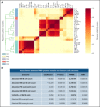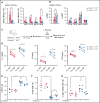Decreased IL-10 accelerates B-cell leukemia/lymphoma in a mouse model of pediatric lymphoid leukemia
- PMID: 34727170
- PMCID: PMC8945291
- DOI: 10.1182/bloodadvances.2021005522
Decreased IL-10 accelerates B-cell leukemia/lymphoma in a mouse model of pediatric lymphoid leukemia
Abstract
Exposures to a wide repertoire of common childhood infections and strong inflammatory responses to those infections are associated with the risk of pediatric B-cell acute lymphoblastic leukemia (B-ALL) in opposing directions. Neonatal inflammatory markers are also related to risk by unknown mechanism(s). Here, we demonstrate that interleukin-10 (IL-10) deficiency, which is associated with childhood B-ALL, indirectly impairs B lymphopoiesis and increases B-cell DNA damage in association with a module of 6 proinflammatory/myeloid-associated cytokines (IL-1α, IL-6, IL-12p40, IL-13, macrophage inflammatory protein-1β/CCL4, and granulocyte colony-stimulating factor). Importantly, antibiotics attenuated inflammation and B-cell defects in preleukemic Cdkn2a-/-Il10-/- mice. In an ETV6-RUNX1+ (E6R1+) Cdkn2a-/- mouse model of B-ALL, decreased levels of IL-10 accelerated B-cell neoplasms in a dose-dependent manner and altered the mutational profile of these neoplasms. Our results illuminate a mechanism through which a low level of IL-10 can create a risk for leukemic transformation and support developing evidence that microbial dysbiosis contributes to pediatric B-ALL.
© 2022 by The American Society of Hematology. Licensed under Creative Commons Attribution-NonCommercial-NoDerivatives 4.0 International (CC BY-NC-ND 4.0), permitting only noncommercial, nonderivative use with attribution. All other rights reserved.
Figures





Similar articles
-
Lessons from mouse models in the impact of risk factors on the genesis of childhood B-cell leukemia.Front Immunol. 2023 Oct 12;14:1285743. doi: 10.3389/fimmu.2023.1285743. eCollection 2023. Front Immunol. 2023. PMID: 37901253 Free PMC article. Review.
-
Granulocyte-colony stimulating factor, granulocyte-macrophage colony stimulating factor, PIXY-321, stem cell factor, interleukin-3, and interleukin-7: receptor binding and effects on clonogenic proliferation in acute lymphoblastic leukemia.Leuk Lymphoma. 1994 Dec;16(1-2):79-88. doi: 10.3109/10428199409114143. Leuk Lymphoma. 1994. PMID: 7535143
-
Non-leukemic pediatric mixed phenotype acute leukemia/lymphoma: Genomic characterization and clinical outcome in a prospective trial for pediatric lymphoblastic lymphoma.Genes Chromosomes Cancer. 2019 Jun;58(6):365-372. doi: 10.1002/gcc.22726. Epub 2019 Jan 21. Genes Chromosomes Cancer. 2019. PMID: 30578714 Clinical Trial.
-
Novel ETV6-RUNX1 Mouse Model to Study the Role of ELF-MF in Childhood B-Acute Lymphoblastic Leukemia: a Pilot Study.Bioelectromagnetics. 2019 Jul;40(5):343-353. doi: 10.1002/bem.22193. Epub 2019 Jun 3. Bioelectromagnetics. 2019. PMID: 31157932
-
C-kit receptors in childhood malignant lymphoblastic cells.Leuk Lymphoma. 1997 Apr;25(3-4):201-16. doi: 10.3109/10428199709114160. Leuk Lymphoma. 1997. PMID: 9168431 Review.
Cited by
-
Immune Microenvironment in Childhood Cancers: Characteristics and Therapeutic Challenges.Cancers (Basel). 2024 Jun 12;16(12):2201. doi: 10.3390/cancers16122201. Cancers (Basel). 2024. PMID: 38927907 Free PMC article. Review.
-
Decreased IL-10R-expressing B Cells in breast cancer patients: a potential biomarker for early cancer detection.Am J Clin Exp Immunol. 2025 Feb 25;14(1):34-42. doi: 10.62347/VYQY9361. eCollection 2025. Am J Clin Exp Immunol. 2025. PMID: 40134823 Free PMC article.
-
Age and ligand specificity influence the outcome of pathogen engagement on preleukemic and leukemic B-cell precursor populations.Blood Adv. 2023 Nov 28;7(22):7087-7099. doi: 10.1182/bloodadvances.2023010782. Blood Adv. 2023. PMID: 37824841 Free PMC article.
-
The RUNX Family of Proteins, DNA Repair, and Cancer.Cells. 2023 Apr 7;12(8):1106. doi: 10.3390/cells12081106. Cells. 2023. PMID: 37190015 Free PMC article. Review.
-
Vitamin C Inhibits Lipopolysaccharide-Induced Hyperinflammatory State of Chronic Myeloid Leukemia Cells through Purinergic Signaling and Autophagy.Nutrients. 2024 Jan 29;16(3):383. doi: 10.3390/nu16030383. Nutrients. 2024. PMID: 38337668 Free PMC article.
References
-
- Hjalgrim LL, Rostgaard K, Hjalgrim H, et al. . Birth weight and risk for childhood leukemia in Denmark, Sweden, Norway, and Iceland. J Natl Cancer Inst. 2004;96(20):1549-1556. - PubMed
-
- Chang JS, Tsai C-R, Tsai Y-W, Wiemels JL. Medically diagnosed infections and risk of childhood leukaemia: a population-based case-control study. Int J Epidemiol. 2012;41(4):1050-1059. - PubMed

